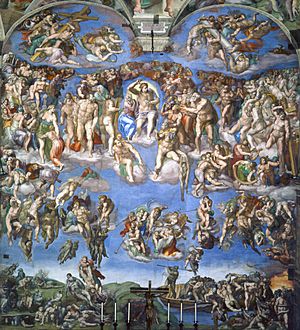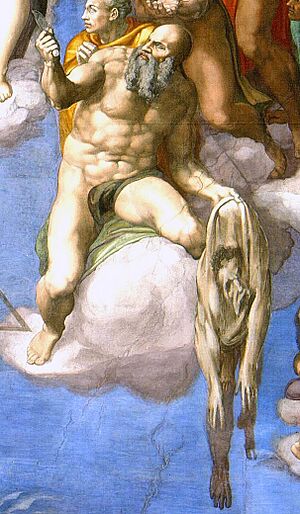The Last Judgement (Michelangelo) facts for kids
The Last Judgment is a huge painting called a fresco. It was painted by the famous artist Michelangelo. You can find it on the altar wall of the Sistine Chapel in Vatican City.
A leader of the church, Pope Clement VII, asked Michelangelo to paint it in 1534. Michelangelo was 61 years old when he started working on it in 1536, after a new Pope, Paul III, took over. He finished the painting in 1541.
Contents
The Last Judgment Painting
What the Painting Shows
The painting shows a very important moment from the Bible. It's about the Second Coming of Jesus Christ. This is when, according to the Book of Revelation, Jesus returns to Earth.
Michelangelo's painting shows a time when everyone, both the living and the dead, is judged by Christ. Their souls are then sent to either Heaven or Hell. It's a powerful scene with many figures.
Why It Caused a Stir
When the painting was finished, not everyone loved it. Some people were upset because Michelangelo had painted many holy people without clothes. They thought this was wrong for such an important church.
A cardinal even said that these naked figures should not be in the most important church for Christianity. A special effort was started to cover up the naked bodies. This was known as the "Fig-leaf campaign."
One of the Pope's own helpers, Biagio da Cesena, said the painting was "disgraceful." He thought it looked more like something for public baths than a church. Michelangelo heard about this. So, he painted Cesena's face onto a character in the painting. This character was Minos, the judge of the underworld, located in the bottom-right corner.
It is said that Cesena complained to the Pope about this. But the Pope joked that his power did not reach Hell, so the portrait would have to stay!
Later, another artist named Daniele da Volterra was hired to add light cloths or "breeches" to cover some of the naked figures. Because of this, Daniele da Volterra was given the funny nickname "Il Braghettone," which means "the breeches-painter."
Michelangelo's Secret Message
Michelangelo also included a secret message in the painting. He painted a self-portrait of himself as St. Bartholomew. St. Bartholomew was a saint who was tortured. In the painting, St. Bartholomew holds his own skin.
Michelangelo painted his own face on this skin. Some people think this shows how Michelangelo felt about being asked to paint "The Last Judgment." Perhaps he felt like he was being tortured by the difficult task and the criticism.
Images for kids
-
Angels at the top left, one with the Crown of Thorns
-
Saint Peter with his keys
See also
 In Spanish: El Juicio Final (Capilla Sixtina) para niños
In Spanish: El Juicio Final (Capilla Sixtina) para niños














